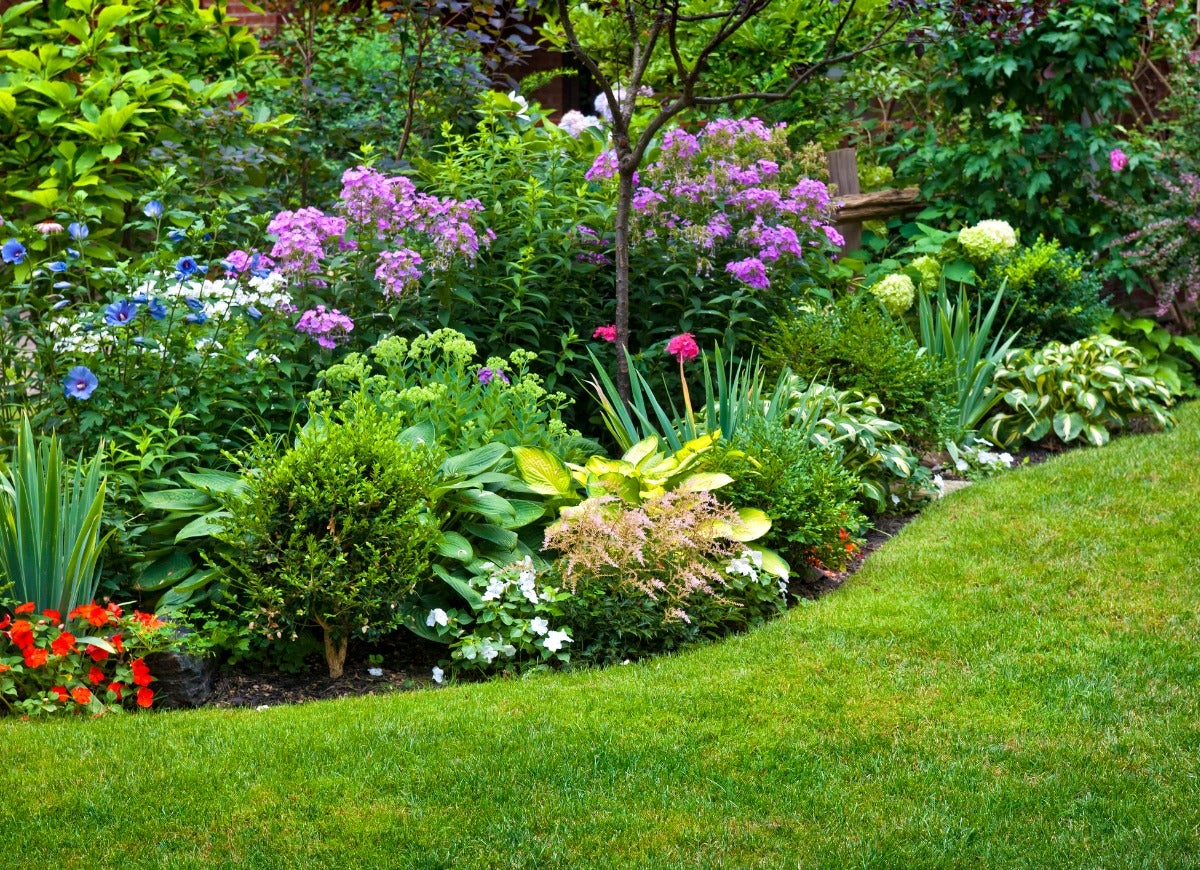

We may earn revenue from the products available on this page and participate in affiliate programs. Learn More ›
Because plants derive their energy from sunlight, most flowering shrubs like lots of it. Of course, the degree to which plants thrive in the sun often depends on how intense the sunlight is in your area—the nearer you are to the equator, the more intense it is. Bushes that happily bask in full sun in northern zones might haplessly bake in southern ones.
Ahead, we’ve collected some stunning shrubs that can withstand heat and full sun, as long as they don’t dry out. Diane Blazek, executive director at the National Garden Bureau, offers her expert advice about what sun-loving shrubs can do for your landscape, and which ones work best in your hardiness zone. With her help, you’ll discover a range of full-sun shrubs that will flourish in your yard’s sunniest spots.
What are full-sun shrubs?
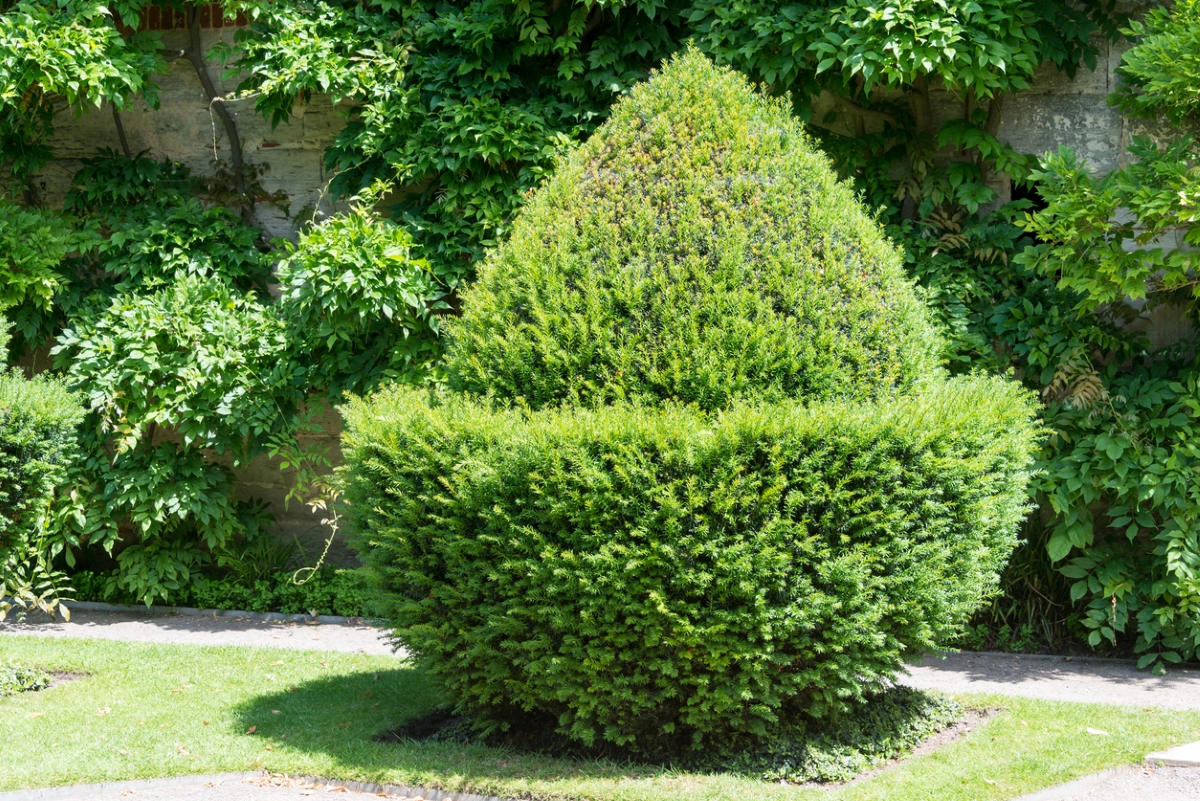
Shrubs are plants that have multiple woody stems and come in various shapes and sizes, from dwarf sizes under 2 feet tall to some that reach higher than 20 feet. Shrubs are considered perennials; some offer greenery year-round, while others shed leaves when the cold weather arrives. In addition to their green foliage, there are flowering shrubs for full sun that bloom in various hues, bear fruits, or feature compelling bark textures.
As for plant light requirements, full-sun shrubs should receive a minimum of 6 hours of direct summer sun each day. Areas of your yard that aren’t hidden in shadow from trees or structures may benefit aesthetically from full-sun shrubs.
Blazek’s advice about incorporating a sun-loving shrub into your landscape is to lean into variety. “Think in terms of layering and mixing shapes and textures,” she says. “Mix in mounded shrubs with those that are columnar or weeping/cascading. Mix dark green foliage with chartreuse foliage. Plant taller shrubs or trees in back, then layer mid-height shrubs with smaller shrubs and perennials then add ground-hugging plants in the front of the border.”
Blazek recommends following the guidance on the plant’s label (or those provided by the retailer) when planting shrubs. Always consider the full size of the shrub before you put it in the ground; you want to give it enough room to shine in its natural state and shape. Finally, remember that shrubs typically need a year in the ground and and some TLC (like extra watering) to get established, but after that point they should require little maintenance.
Benefits of Full-Sun Shrubs
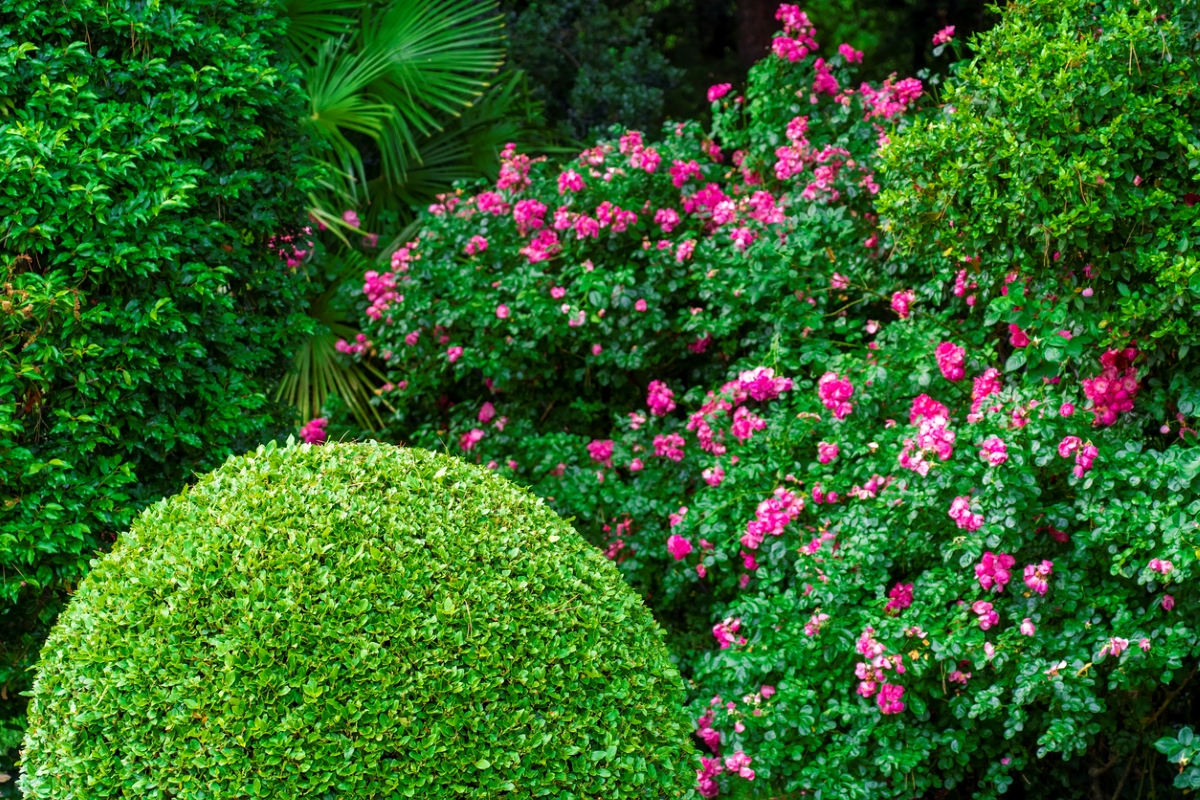
Full-sun shrubs come with the significant benefit of thriving in locations in your outdoor space that could leave other plants a bit crispy. According to Blazek, a few additional advantages of sun-loving shrubs include:
- The variety of colors and textures they bring to the yard can make your outdoor space more attractive. If you heed Blazek’s planting advice, mixing different types of sun-loving shrubs can improve the appearance of the landscape.
- Many newer varieties are being bred for compactness, requiring less care and maintenance from the homeowner. These smaller shrubs still need occasional pruning, but the task is on a much smaller scale.
- Newer shrub varieties can also offer more disease resistance and longer bloom times. Selective breeding is a process that cross-pollinates shrubs with desirable traits to create new or improved varieties.
- Sun-loving shrubs create a more diverse landscape, which contributes to a healthy ecosystem. Shrubs can provide habitats for birds and other animals, and some can provide food sources (like berries).
- Early- and late-flowering shrubs can provide pollen sources when blooming perennials and annuals lack pollen.
- Planting shrubs in strategic locations around your property can also provide privacy. Some places you might consider adding sun-loving shrubs include along the property boundary, near an outdoor living space, and near a hot tub.
1. Butterfly Bush (Buddleja spp.)
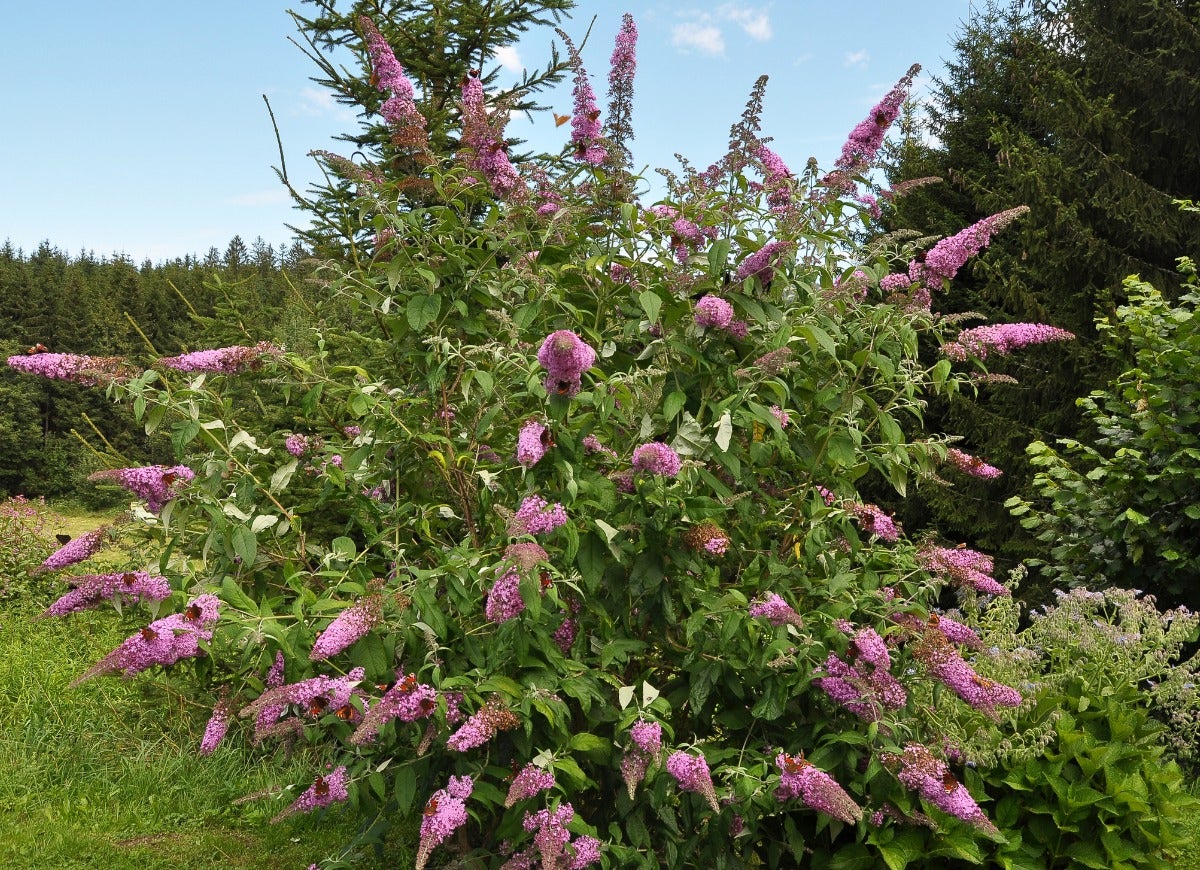
Named for their ability to attract butterflies with their nectar, these bushes grow from 5 to 15 feet high and feature clusters of tiny blooms in a wide variety of colors. The toughest B. davidii species are hardy to USDA Zone 5. Butterfly bushes remain controversial because they can crowd out butterfly larvae’s native host plants in some growing regions. For that reason, gardeners in mild climates where buddlejas are likely to become aggressive should choose sterile cultivars that can’t reproduce.
2. California Lilac (Ceanothus spp.)
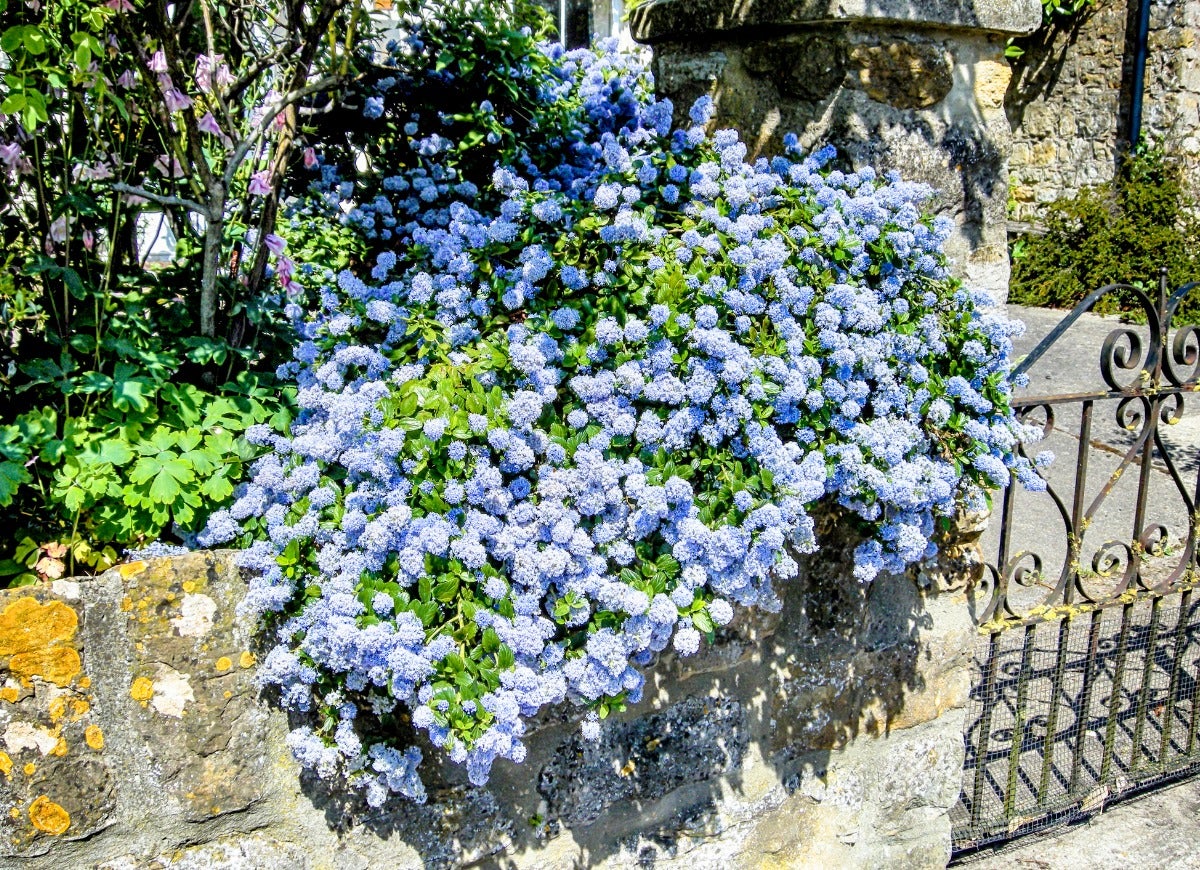
If your sunny site scorches dry during the summer, you’ll appreciate California lilacs. As with the more common lilacs, they usually produce their sweet-scented clusters of blue or white blooms in spring. But shrubs of this entirely different genus are often evergreen, vary in height from 1 to 30 feet, and tolerate arid summer conditions. Most lilac varieties are perennial only in USDA Zone 7 or higher, but New Jersey tea (Ceanothus americanus) is the exception; it is hardy to Zone 3.
3. Chaste Tree (Vitex agnus-castus)
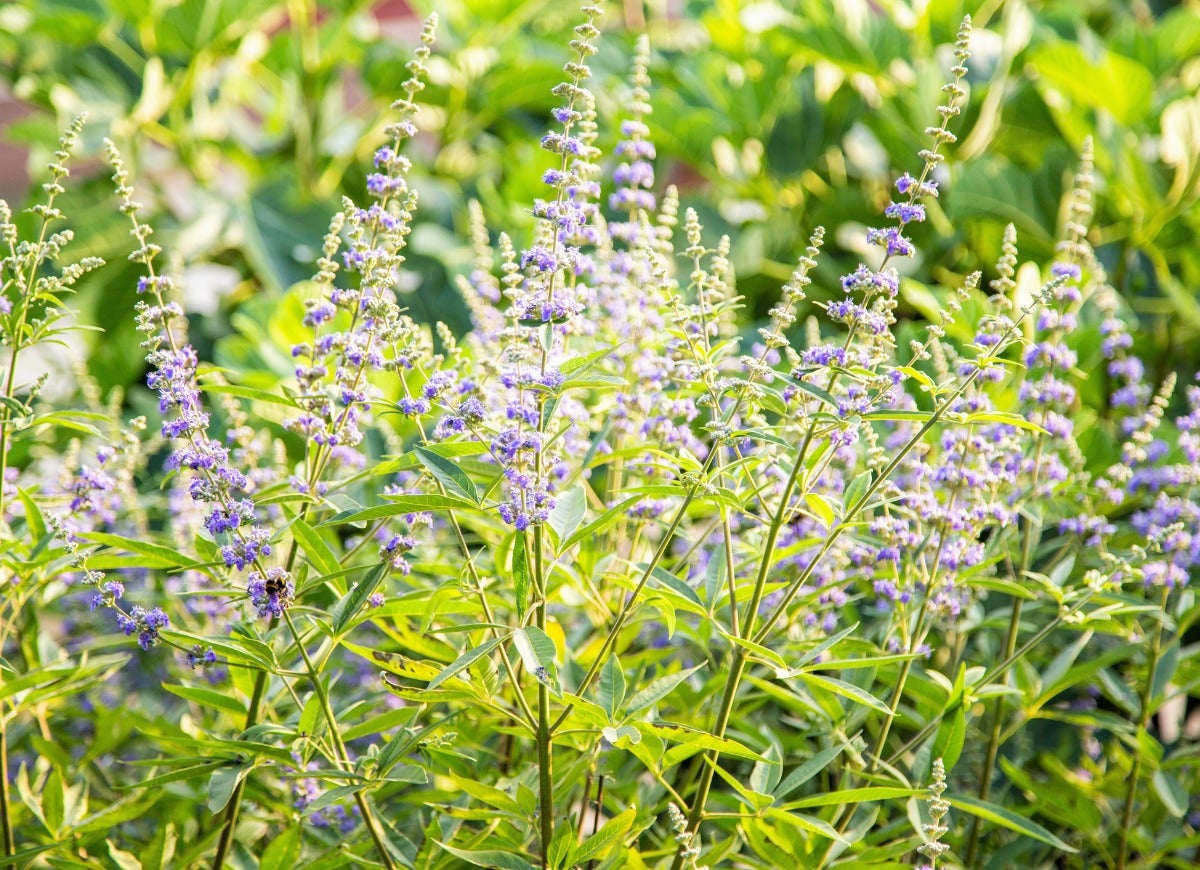
Though this vitex can be shaped into a tree that grows up to 25 feet high in the more southern zones of its range, it generally remains shrubby in northern areas, where it dies back to the ground every winter and doesn’t surpass 3 to 5 feet during the growing season. It makes fragrant spikes of chastely muted but classy white, pink, or—more typically—pale purple blooms framed by silvery foliage for most of the summer and autumn in USDA Zones 7 through 11.
RELATED: The Dos and Don’ts of Pruning a Bush
4. Shrubby Cinquefoil (Potentilla fruticosa)
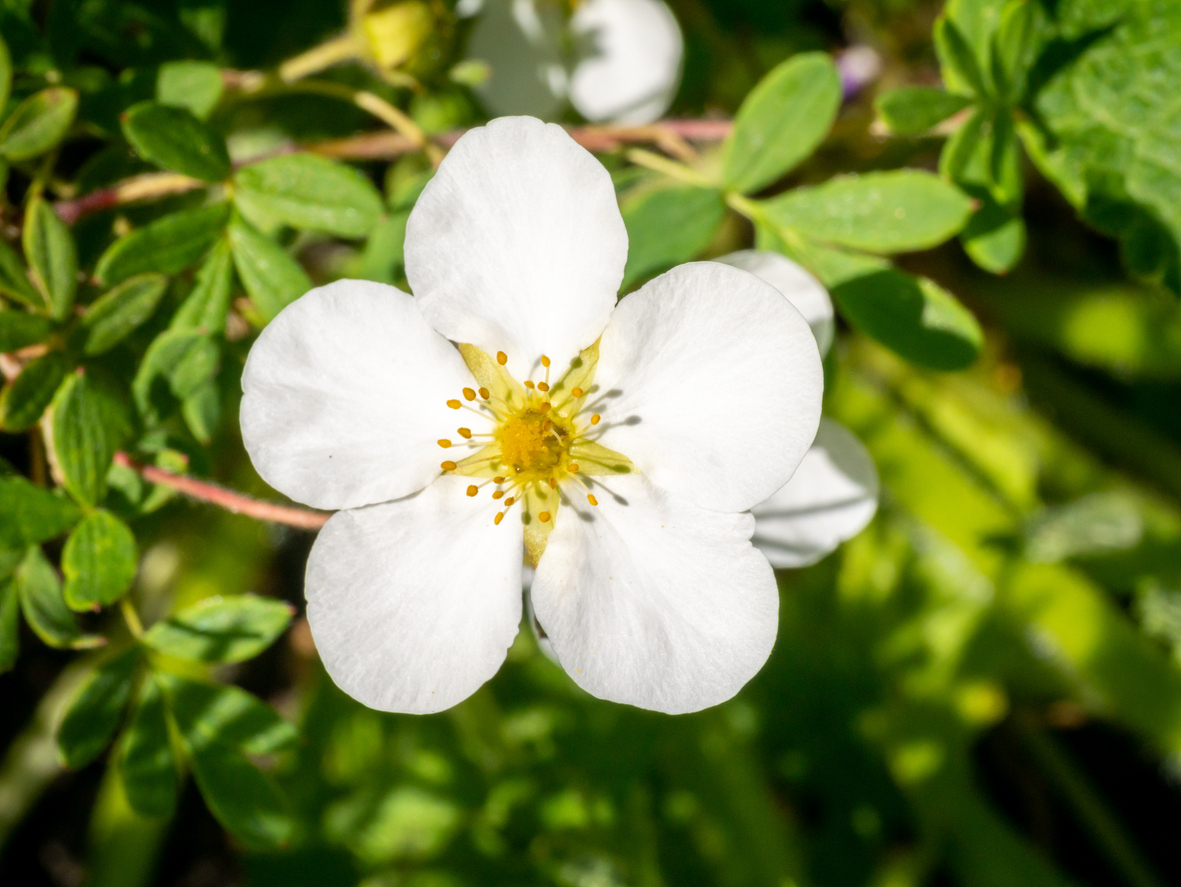
With 1½- to 2-inch blooms resembling oversize strawberry blossoms in white, pink, yellow, and orange shades, shrubby cinquefoil cultivars range from 2 feet to more than 4 feet high. Hardiness varies according to cultivar, but the shrub generally does well in USDA zones 2 through 9. Although the plants prefer full sun in northern zones, too much sun can fade the color of their blooms in the South. Gardeners there might want to opt for morning sun and afternoon shade when planting their cinquefoil.
5. Flowering Quince (Chaenomeles spp.)
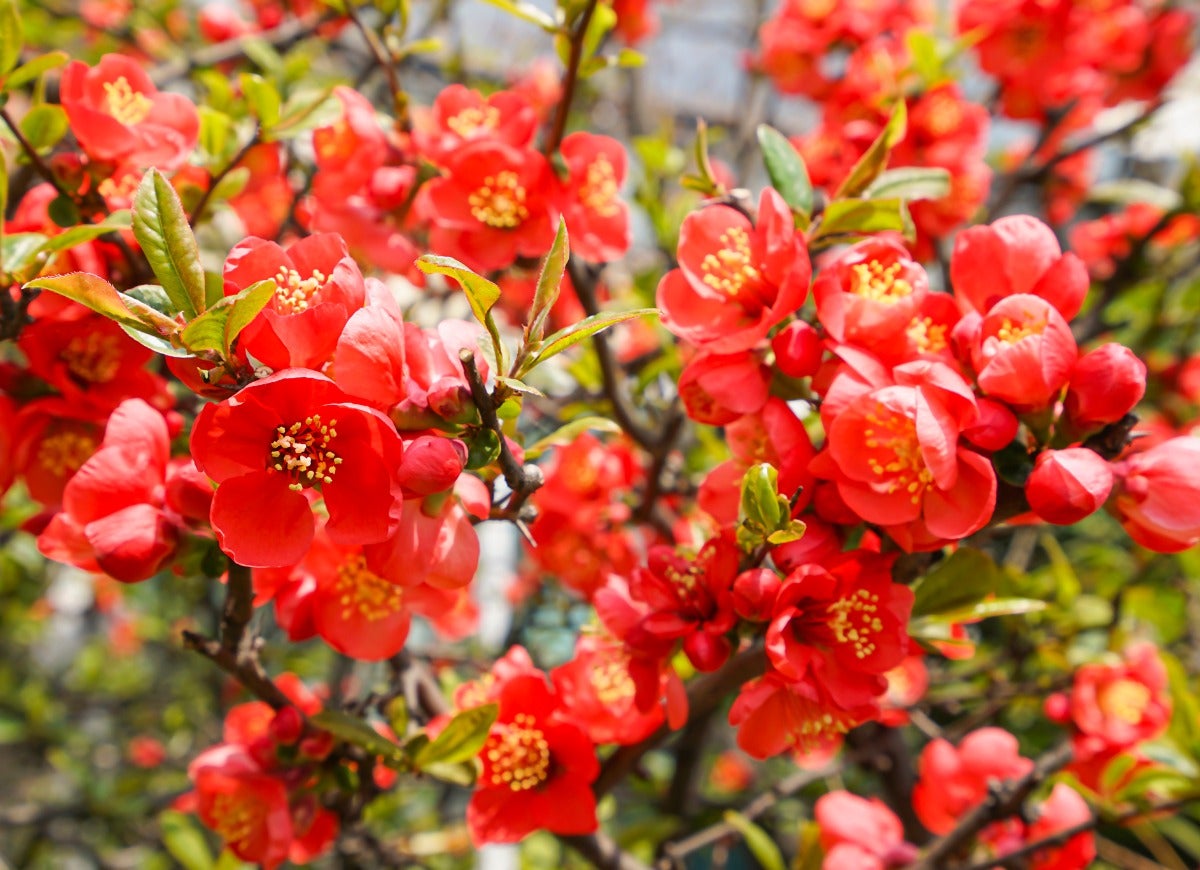
Among the first bushes to blaze into bloom in spring, sun-loving flowering quinces are often called fire bushes for their most common single orange or red 1½- to 2½ -inch flowers and ruddy-tinged new foliage. These blooms, however, also come in white, pink, or double versions in USDA zones 5 through 10. Growing 3 to 10 feet tall, flowering quinces sometimes produce small fruits, but they are not the same genus as the quince fruit tree.
6. Lantana (Lantana spp.)
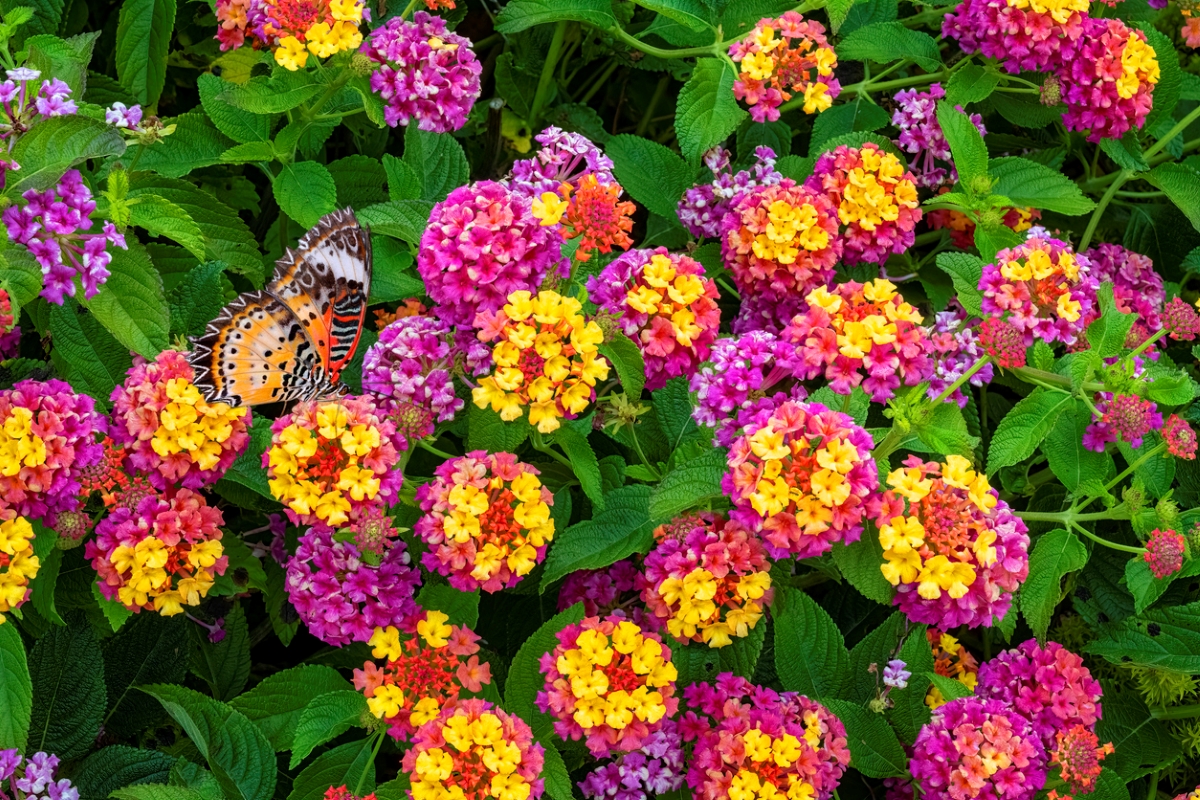
Shrubs that gardeners either love or love to hate, lantanas have a fruity but somewhat peculiar scent that purportedly contains notes of gasoline and tomcat. However, that odor becomes obvious only when the plant is bruised or broken. Varying in height from 2 to 6 feet, the small shrubs for full sun produce their often multicolored clusters of small flowers for much of the year in USDA Zones 8 through 11. In cooler zones, gardeners typically grow lantanas as annuals or container plants.
7. Oleander (Nerium spp.)
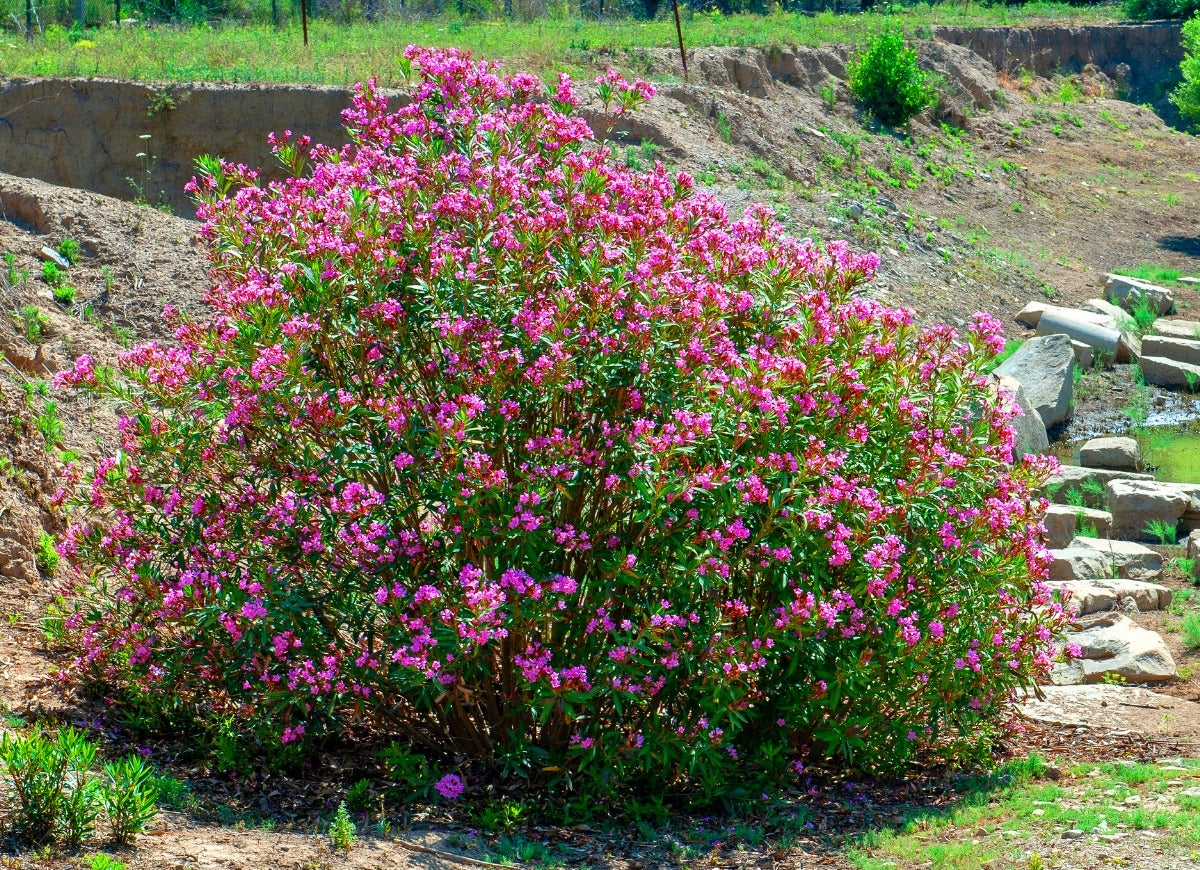
“Killer” shrubs that can bloom from late spring to autumn in USDA Zones 8 through 11, oleanders grow from 3 to 20 feet high with 2- to 3-inch funnel-shaped flowers in white, yellow, pink, or red. It’s worth noting that prudent gardeners should take that “killer” moniker literally, since the glossy leaves of these full-sun evergreen shrubs are highly toxic. They’re also prone to an insect-spread scorch disease caused by bacteria rather than the sun. As a result, gardeners should be cautious about oleanders’ placement and care.
8. Rockrose (Cistus spp.)
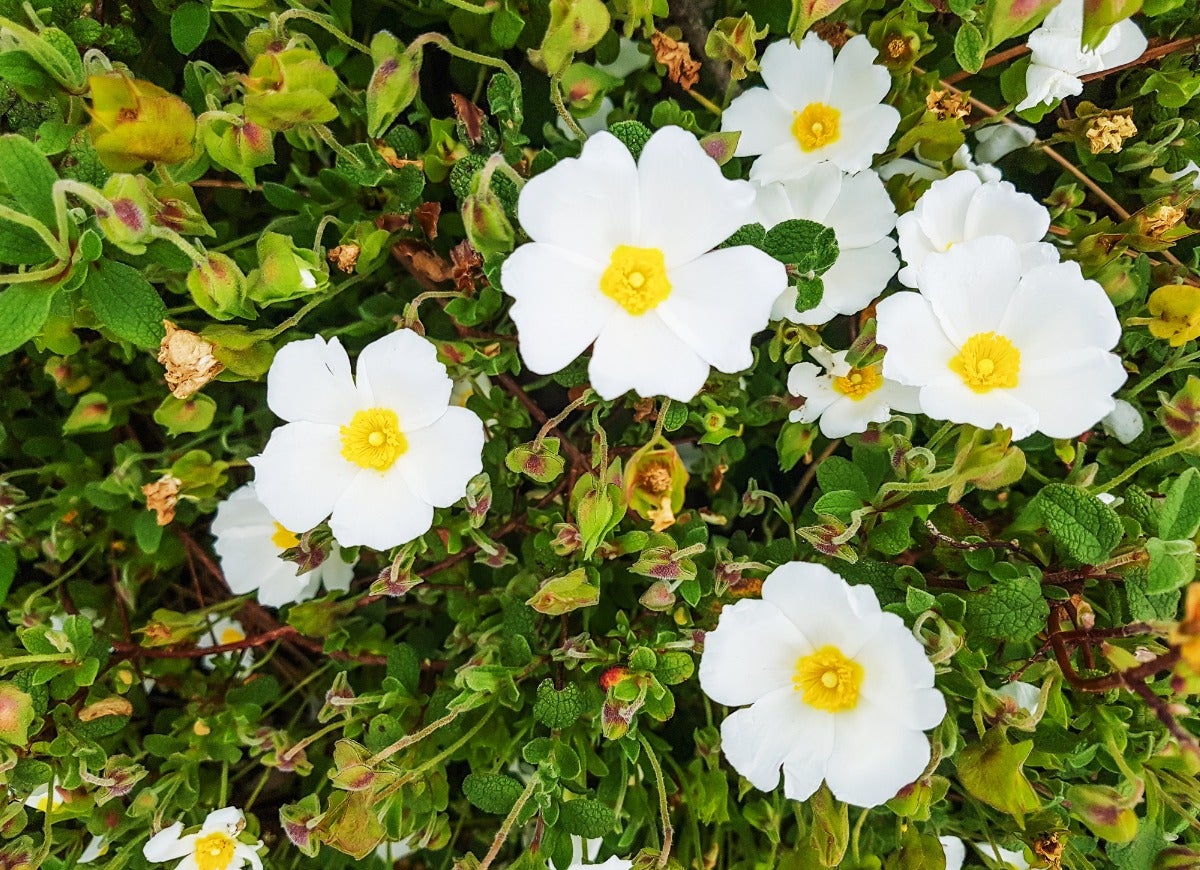
Growing from 2 to 6 feet tall with striking, 1½- to 4-inch flowers that somewhat resemble single roses, rockroses generally bloom most heavily in late spring and into early summer in USDA zones 7 or higher. They might flower sporadically thereafter when happy. Also valued for their resiny, wooly, or silvery foliage, they can rock a rock garden even when not in bloom.

Tried-and-True Advice
“After years of growing in dry, high-altitude regions of New Mexico, I’ve learned that any plant recently transplanted needs extra care for the first week or two. In addition to requiring more water than the label suggests the first year, full-sun shrubs might need a little shade right after planting. Transplanting a shrub from its nursery container to the ground sends the plant into brief shock as it adapts to its new location. That’s especially true if you plant a little late in the season or happen to plant right before unusually high temperatures outdoors.
So, give your new sun-loving shrub a little shade on hot afternoons until it starts to settle and perk up, gradually introducing more sun if you can. Slide container-grown plants into a spot that shades them during peak afternoon heat or rig some temporary shade for in-ground plants. I’ve used folding webstrap lawn chairs turned upside down and shade cloth clipped to a fence or tomato cage. Whatever you choose, keep it from rubbing against the plant or blocking airflow and place it so shade strikes most of the shrub during the hottest hours of the day.”
—Teresa Odle, Contributing Editor and Writer
9. Rose (Rosa spp.)
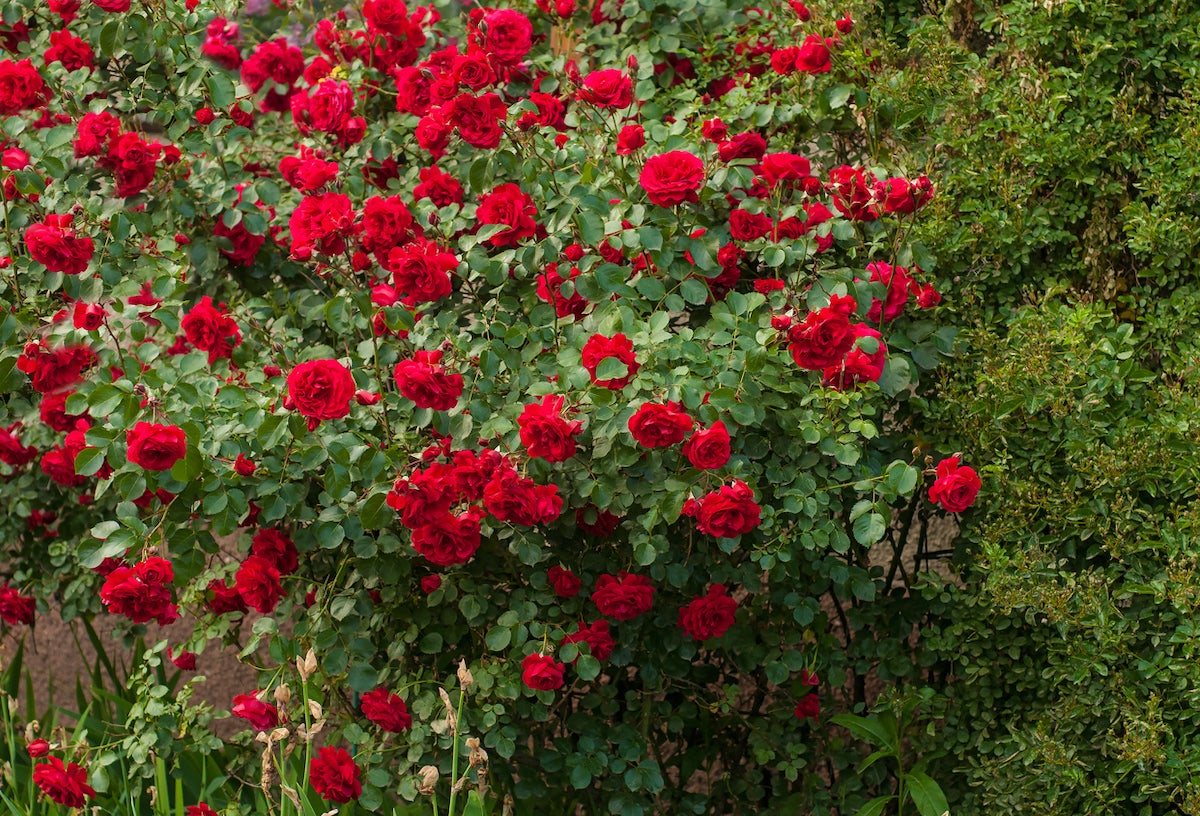
It is feasible to grow roses in almost every USDA zone, with the possible exception of chilly Zone 1. Types of roses vary in size from diminutive miniatures to ramblers that can climb 50 feet. Although a few might bloom in partial shade, shaded bushes are more prone to lankiness and fungal diseases. These beloved shrubs usually need full sun in the North to “come up roses.” In the Southwest, however, where the sunlight can be especially intense, a little afternoon shade might prove beneficial.
10. Tropical Hibiscus (Hibiscus rosa-sinensis)
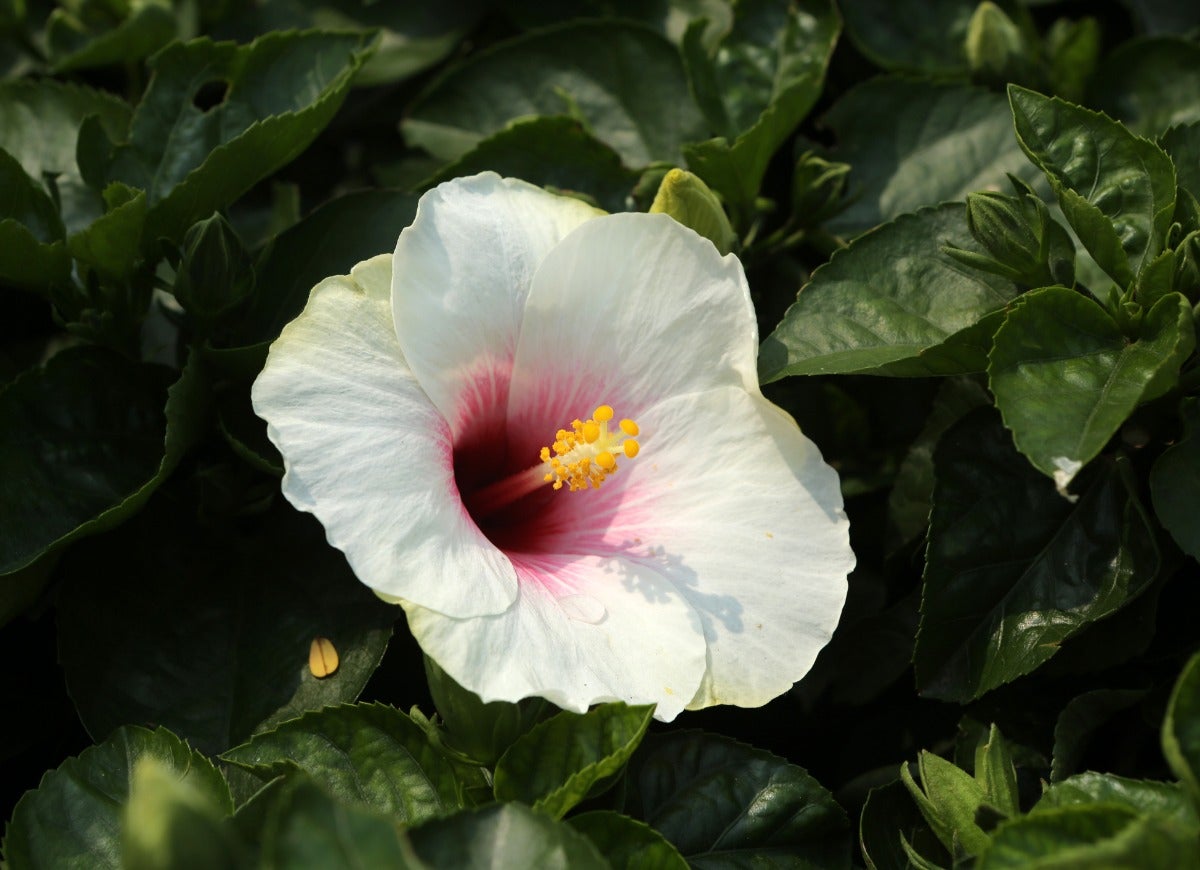
With showy blooms 4 to 8 inches across in a wide variety of colors and in single, semi-double, and double forms, tropical hibiscus shrubs really shine in the sun. They can reach nearly 15 feet high in completely frost-free USDA zones, such as 10 through 12. But they can also persist, if protected, in zones 8 and 9. Elsewhere, hibiscus grows as annuals or houseplants. Keep in mind that the individual flowers last only 1 day—and traditionally were used to shine shoes!
11. Weigela (Weigela spp.)
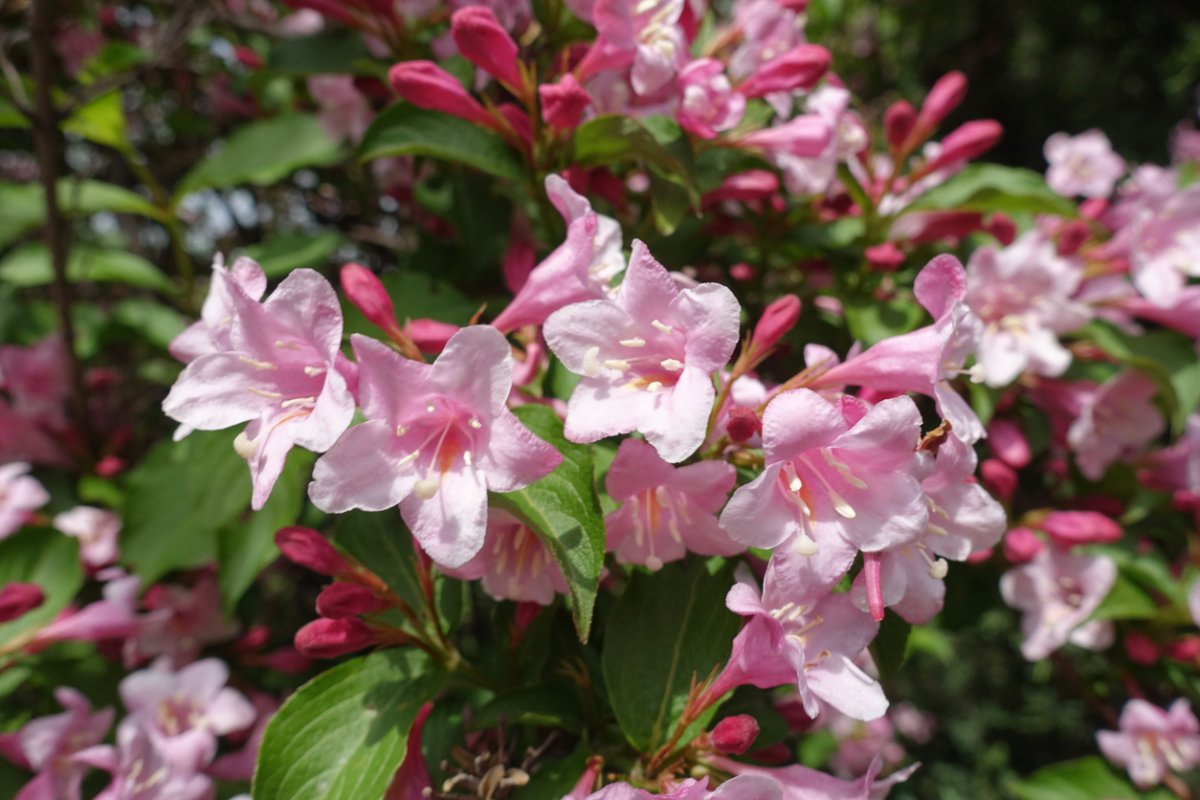
Weigelas wag plenty of funnel-shaped pink or red blooms in spring but can look a bit plain thereafter. Savvy gardeners will opt for variegated or purple-leaved cultivars, which will continue to contribute color to the back of the border in summer. Varying from 3 to 10 feet high, these shrubs are deciduous and will shed their foliage—colorful or not—in autumn; weigelas typically grow in USDA Zones 4 through 8.
12. Crape Myrtle (Lagerstroemia indica)
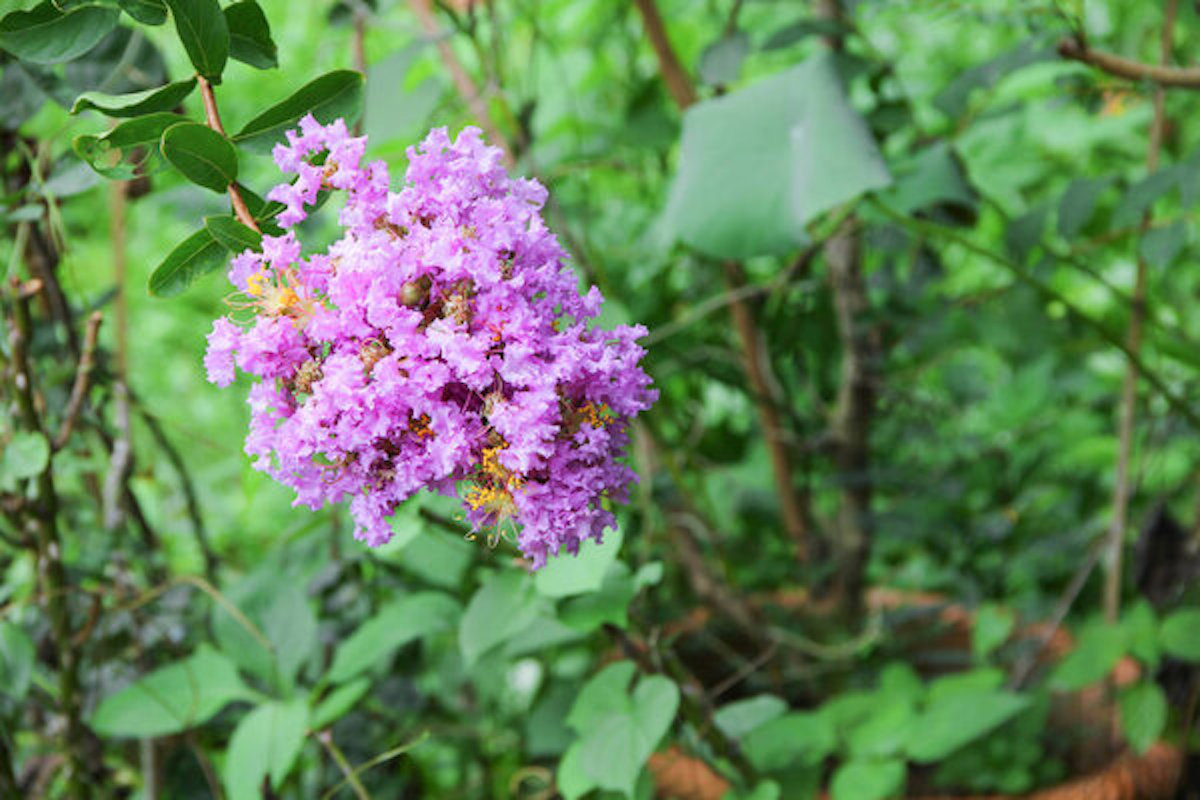
Cultivated worldwide, crape myrtle is a low-maintenance, sun-loving shrub often found in tropical and subtropical climates. Known for its moderately dense, dark green foliage and showy pink flowers, crape myrtle makes for a beautiful hedge or privacy screen.
The roughly 50 types of crape myrtle cultivars in the genus quickly grow into small- to medium-size shrubs or trees. Suited for hardiness zones 6 to 9, crape myrtles thrive in neutral or slightly acidic, well-draining soil. Prune them sparingly in winter or early spring to prompt even more flowering.
13. Spirea (Spiraea spp.)
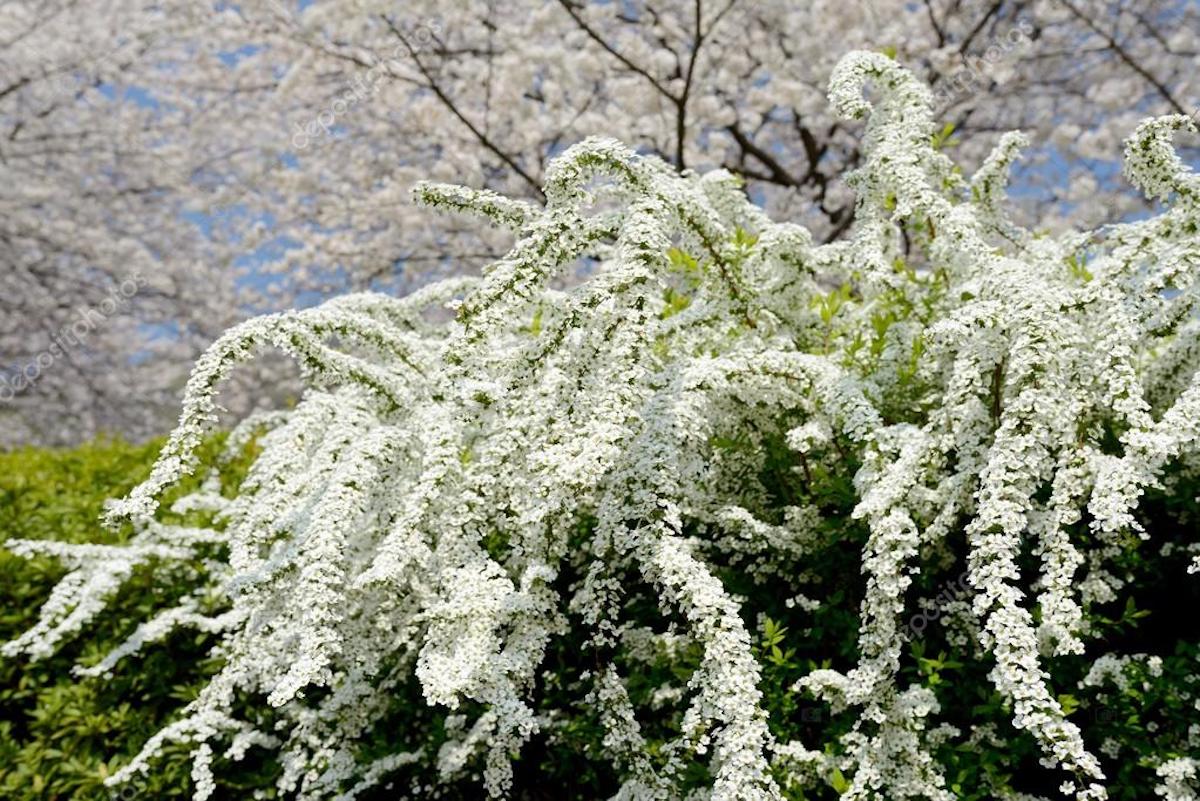
Spirea is a laid-back, full-sun flowering shrub that’s one of the easiest to grow in nearly any garden. It needs well-draining soil, but isn’t particular about soil type or pH. Ranging from 1½ to 8 feet tall, spirea isn’t considered a large plant, but it grows quickly. Some types bloom in spring, while others show off their flowers in summer.
Depending on the species, spirea shrubs fare well in USDA zones 3 through 8. Their flowers may be red, pink, white, or purple, with chartreuse, green, gold, or green-blue foliage.
14. Fairy Magnolia (Magnolia hybrid)
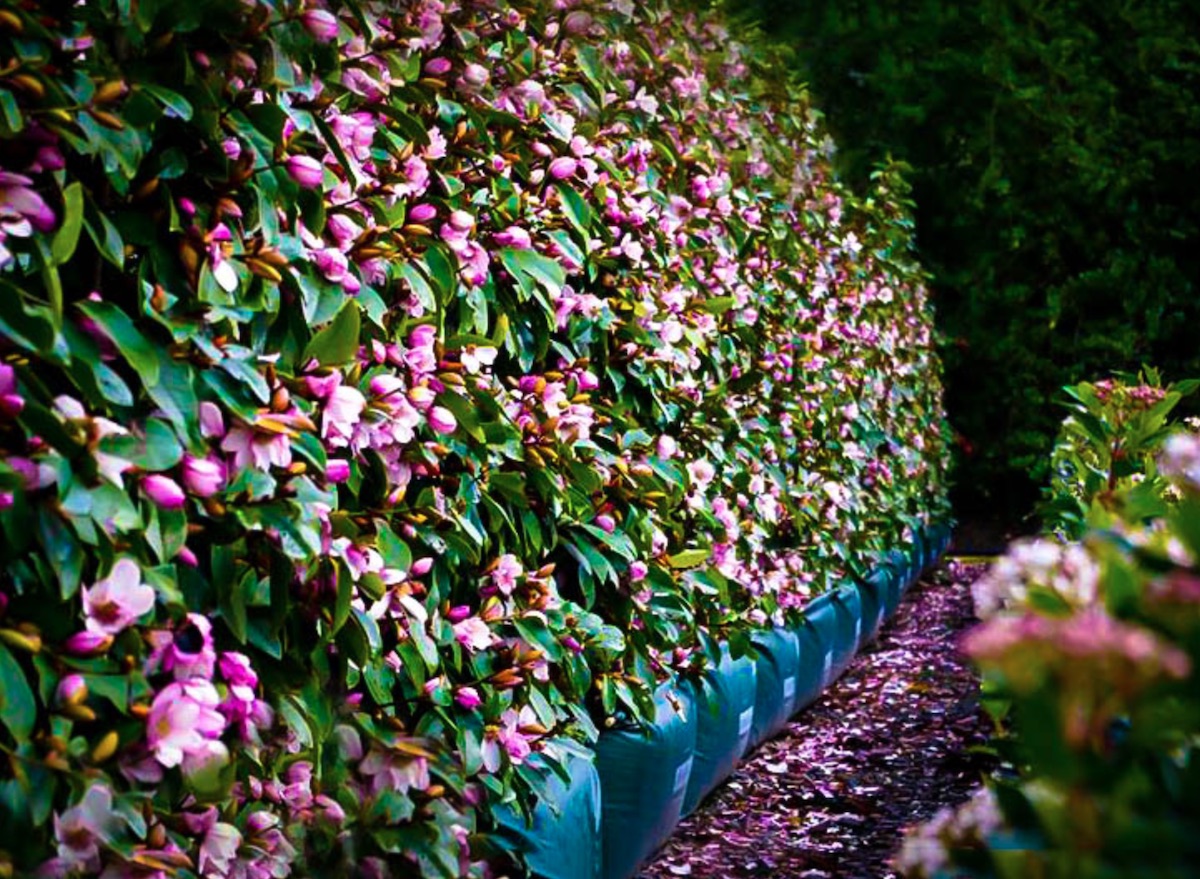
The whimsy of fairy magnolias comes from specialized breeding that yields a relatively new class of magnolia, bearing a more delicate aesthetic than southern magnolias. These shrubs pack a lot of beauty into a single evergreen plant, as their ornate pink, fragrant flowers form all along the branches, and not just at the ends. Dense and bushy, fairy magnolias grow 8 to 12 feet tall and are best suited to zones 7 to 11.
Though remarkable in appearance, these shrubs are low maintenance for easy gardening. They’re happy in most kinds of soil—as long as it’s well draining—and aren’t susceptible to any significant pests or diseases.
15. Glossy Abelia (Abelia x grandiflora ‘Kaleidoscope’)
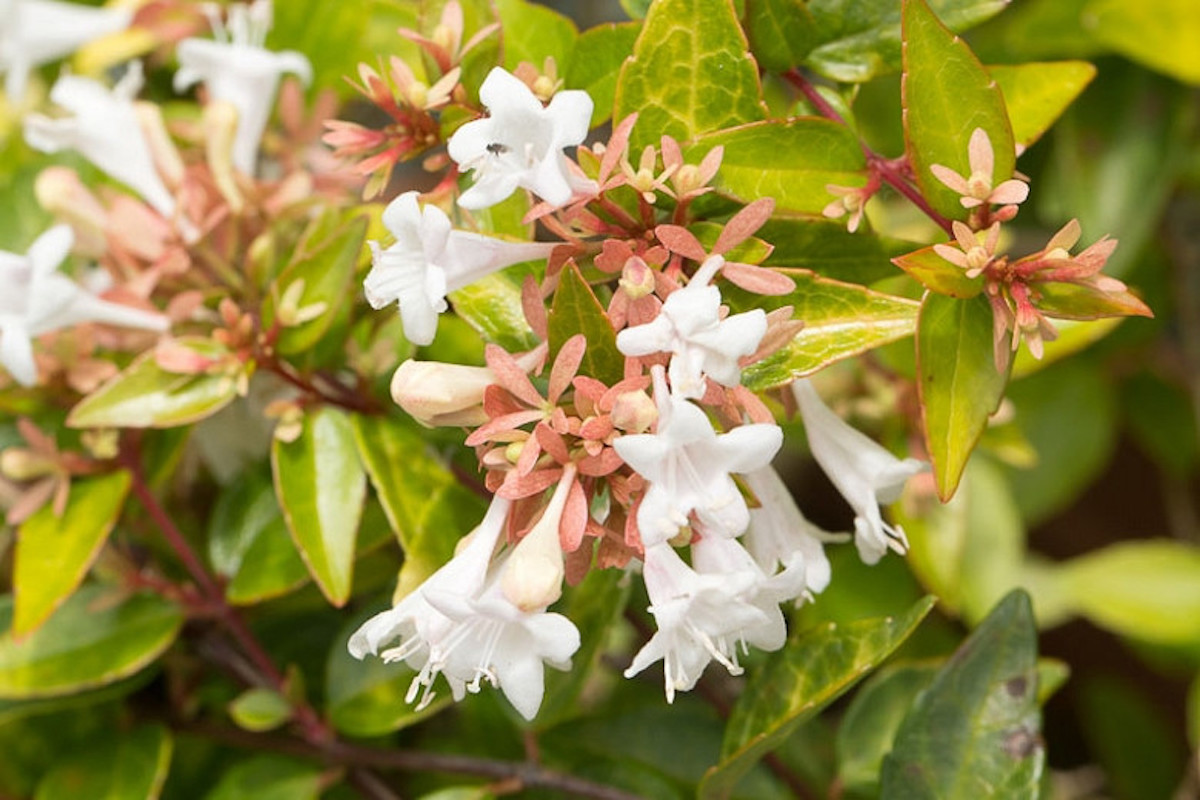
A deciduous shrub known for its color, ‘Kaleidoscope’ glossy abelia offers vibrant foliage that’s only enhanced by full sun exposure. Part of the honeysuckle family, the glossy abelia has a rounded, spreading shape and produces white/pink bell-shaped flowers that bloom from May to September, adding even more color to the shrub. Think twice before pruning it into a more structured shape, as these shrubs tend to look more attractive when they look a little wild and disheveled.
Give the glossy abelia moist, organically rich and well-drained soil to help it thrive—it will do best in zones 5 to 9. Expect these dense, dwarf shrubs for full sun to grow 2 to 4 feet tall unless you’re in the South, where the glossy abelia stays somewhat evergreen and reaches heights of up to 6 feet.
16. Oakleaf Hydrangea (H. quercifolia)
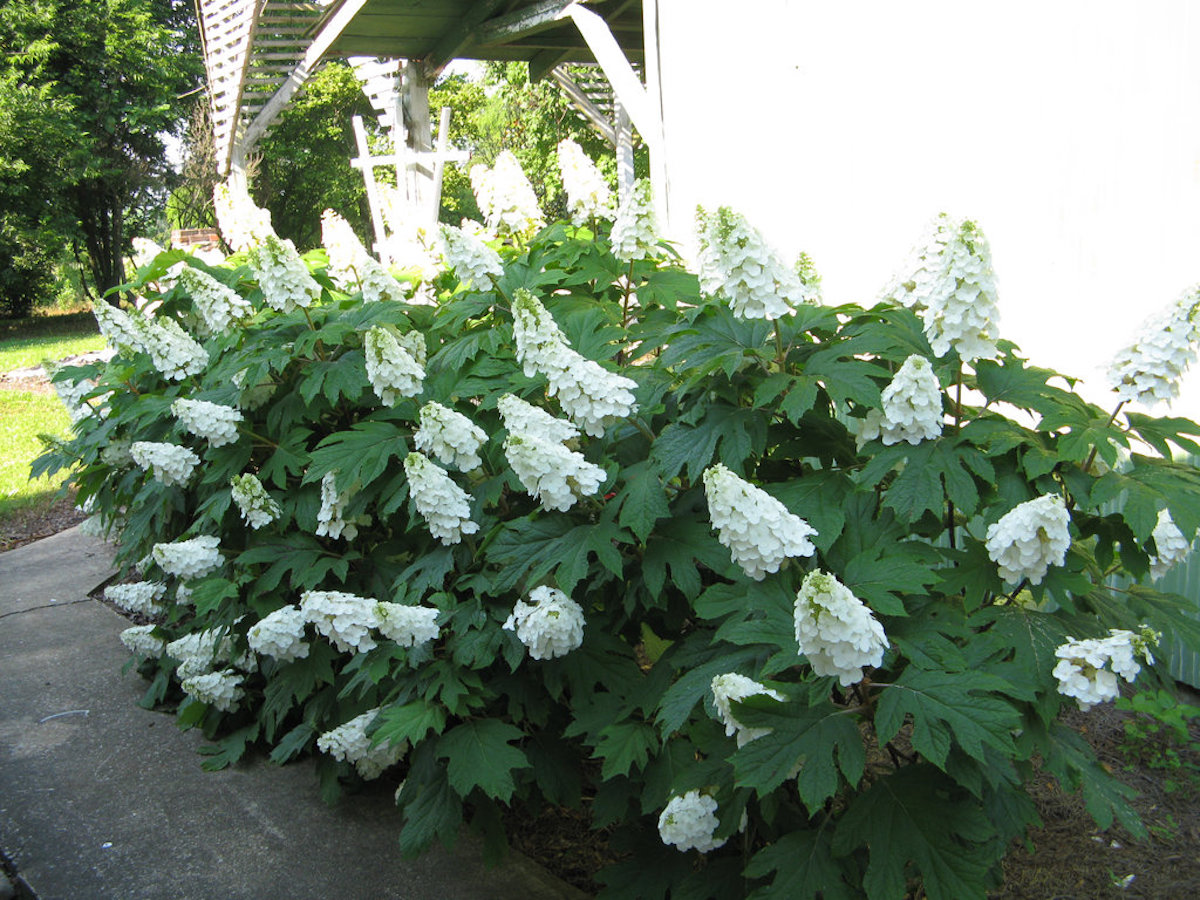
The leaves on an oakleaf hydrangea are similar to the leaves of an oak tree, a resemblance that likely inspired this shrub’s name. Depending on the species, the leaves are 4 to 12 inches long and wide, with a coarse texture. The flowers of this deciduous shrub appear in long, cone-shaped clusters, commonly with single creamy white or soft pink blossoms.
Unlike most hydrangea species, which are Asian in origin, oakleaf hydrangea is native to the southeastern quadrant of the United States and hardy in zones 5 through 9. Also unusual in comparison with other deciduous shrubs, the oakleaf hydrangea has leaves that turn a deep red and don’t slough off until well into the winter season.
17. Elephant Bush (Portulacaria afra)
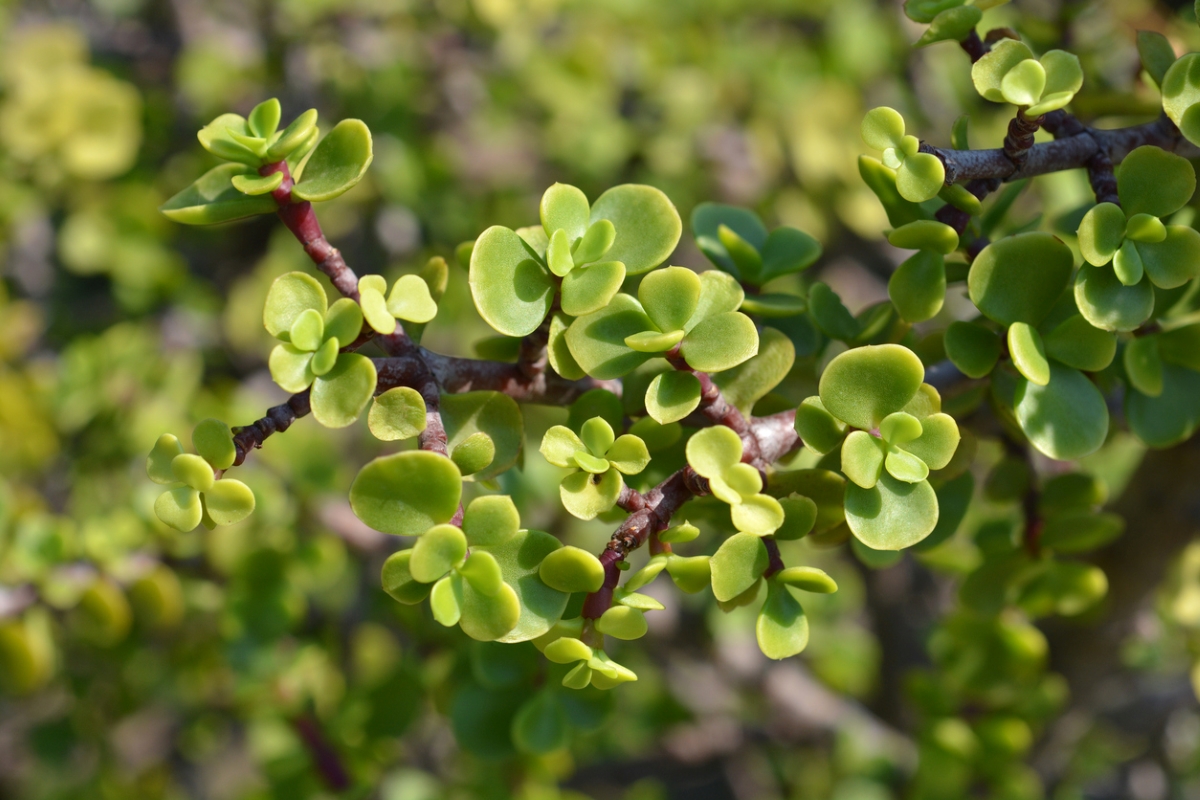
Elephant bush is a perennial succulent shrub that hails from the rocky outcrops and slopes of South Africa and now resides in succulent gardens around the world. Different from other shrubs on this list, the elephant bush prospers in full sun outdoors but is a low-maintenance houseplant too. Elephant bushes have fleshy, fat leaves, much like jade plants, and the foliage is edible, commonly added to soups and salads in southern Africa to give them a sour flavor.
Don’t let the idea of an elephant bush being a succulent fool you. These soft-wooded, semi-evergreen, multi-stemmed shrubs can grow 8 to 15 feet tall in mild climates and do their best in zones 9 to 11.
18. Flamingo Dappled Willow (Salix integra ‘Flamingo’)
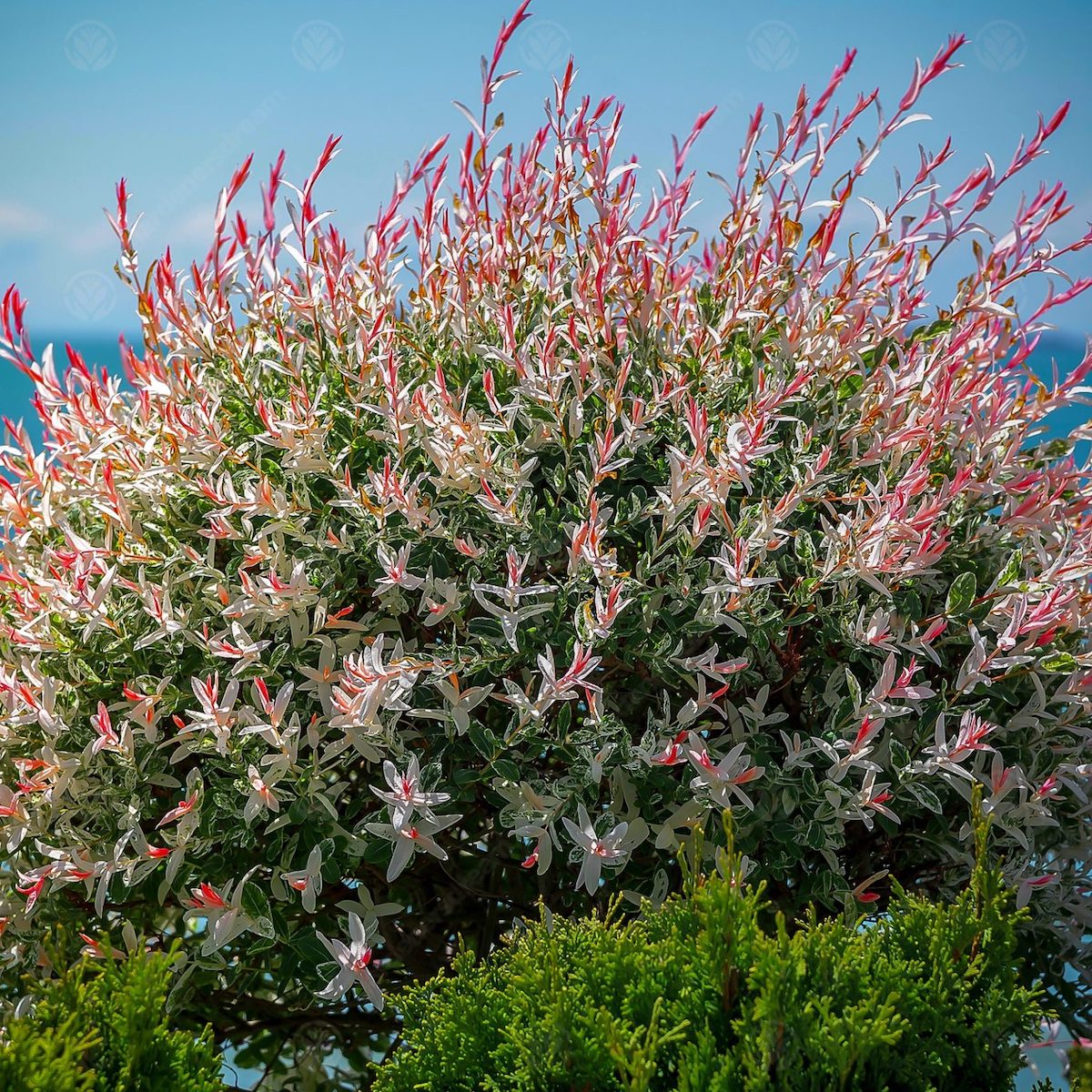
The “flamingo” epithet suits these multi-stemmed ornamental shrubs that have a dense, upright shape and green foliage with touches of cream-white and pink. A fusion of two other willow cultivars, flamingo willows are often used as hedges, borders, or accent features that add a touch of elegance to the garden. They generally grow 5 feet high and spread just as wide in zones 5 to 9. With moderate watering requirements and no particular soil type or pH needed, flamingo willows can live 40 years or more with proper care.
19. Viburnum (Viburnum spp.)

Viburnums bloom with fragrant white or pink flowers in spring, followed by red-hued foliage and berries come fall. These flowering shrubs love rich and slightly acidic soil, and they can be hardy in USDA Zones 2 to 8. Viburnum shrubs vary from 2 to 30 feet in height, and if you like smaller options, Blazek recommends the Compact European Cranberrybush.
Depending on the variety, foliage texture ranges from glossy to velvety, and some of these shrubs can tolerate light shade—though they’ll have the most blooms in full sun. Butterflies flock to their flowers, while birds and other wildlife enjoy their colorful fruits. Resistant to deer, viburnums add charm and seasonal allure to any garden.
20. Dogwood (Cornus florida)
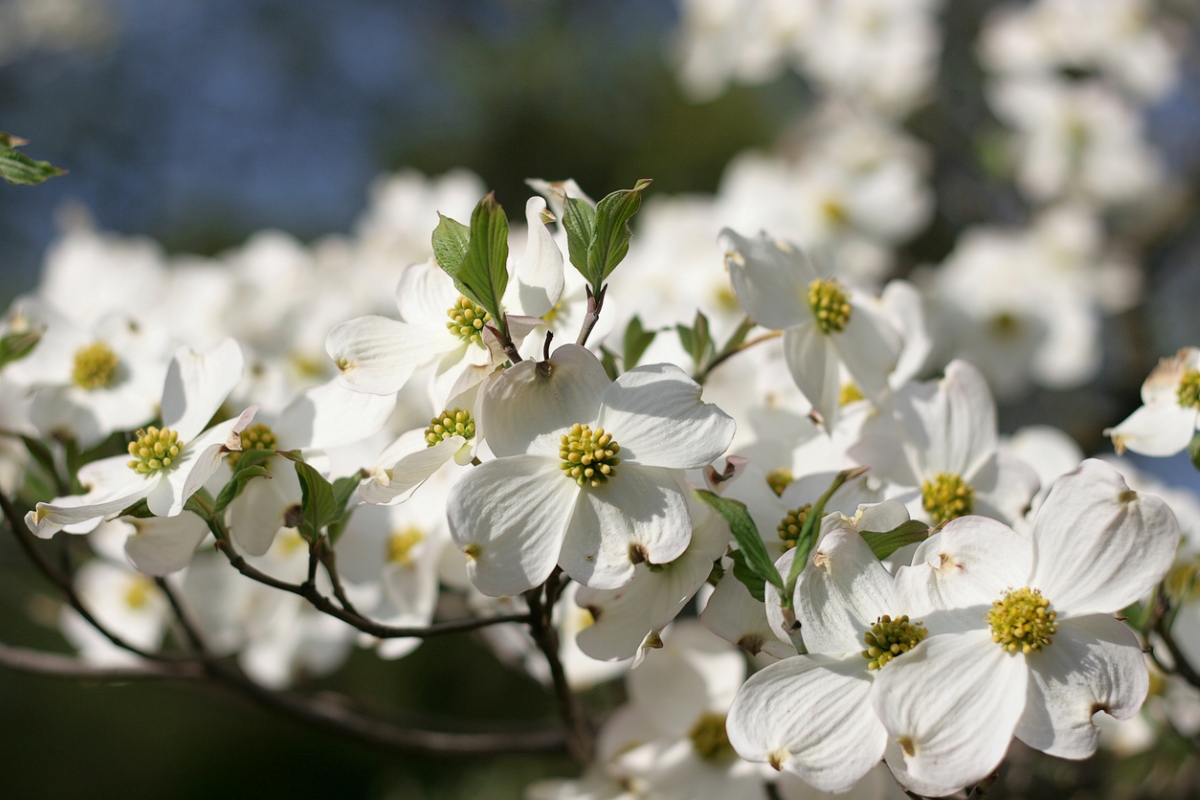
Dogwoods are an incredible flowering shrub that starts to bloom in early spring in colors of white, pink, yellow, or green—providing value to native bees. These plants have low water needs and thrive in acidic soil.
When it comes to the perception of dogwoods, Blazek points out, “They may be thought of as growing fine in the shade, but they do need sun to bloom. For heaviest blooms, plant in full sun. Because there are so many different types and sizes of dogwood, it is recommended that you find one suited for your climate.” The red twig dogwood is a stunning winter shrub with its bare red branches. It grows in USDA Zones 2 through 8.
21. Forsythia (Forsythia spp.)

Forsythia are fast-growing flowering shrubs named after a Scottish botanist. They bear bright yellow, bell-shaped blooms. Some forsythia can survive in zone 3, but hardiness varies by species, with most sitting in zones 5 to 8.
Forsythia shrubs can grow up to 10 feet tall and 12 feet across, depending on the variety. If you love the look of their draping branches but have a smaller space to work with, newer compact varieties like Show Off Starlet are less than 3 feet tall. These sun-loving shrubs require regular pruning, so size is a consideration.
22. Mock Orange (Philadelphus pubescens)

Mock oranges are old-fashioned favorites known for their beautiful flowers and mild, pleasing scent. These flowering shrubs tend to bloom in late spring to early summer, covering themselves with charming, 4-petaled white flowers resembling orange blossoms (hence the common name). The scientific name, however, comes from a Greek word that roughly translates to “brotherly love.”
Native to the Southeastern United States, mock oranges are happiest in zones 6 to 9. Depending on the variety, they can grow up to 10 feet high, and just as wide—however, space-saving varieties, like the Illuminati Arch, can grow to just 4 feet tall. Mock oranges grow easily in well-drained soil with medium moisture in full sun, creating a beautiful shrub border or hedge.
